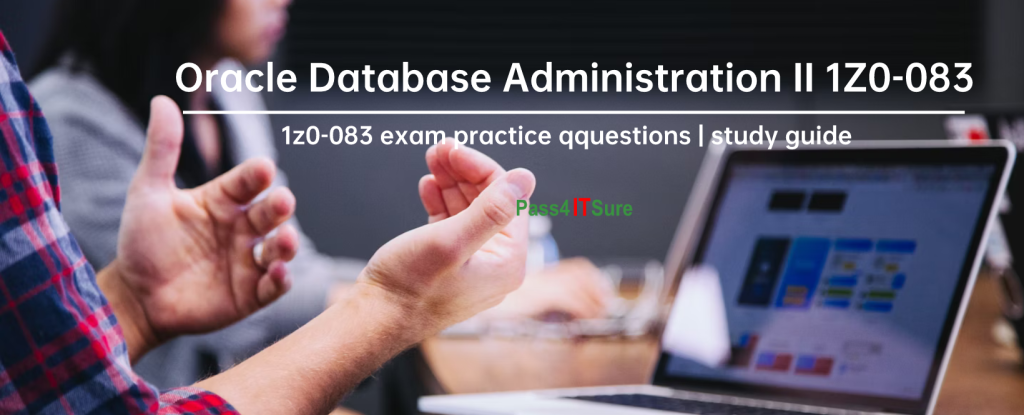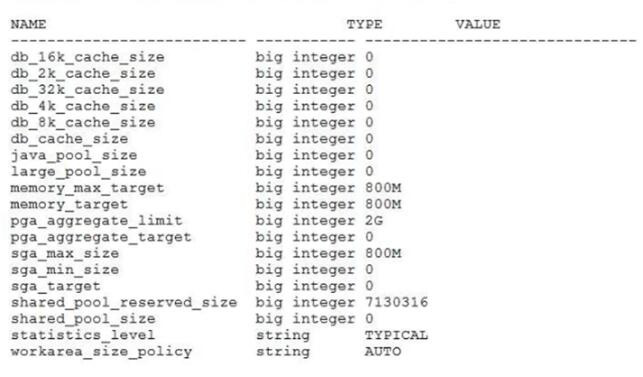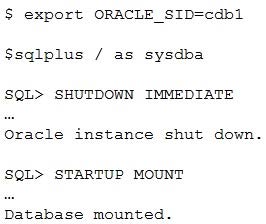Oracle Database Administration II Questions | Study Guide Updated

The new Oracle Database Administration II 1Z0-083 exam practice questions will help you study for the 1Z0-083 exam, and the new 1Z0-083 exam study guide will guide you on what to do to pass the exam. This article has prepared these two for you, and all you need to do is follow in my footsteps and take action.
Get to the Details: Oracle Database Administration II 1Z0-083
Oracle Database Administration II 1Z0-083 exam abbreviation: 1Z0-083
Became after passing the 1Z0-083 exam: Oracle Database Administration 2019 Certified Professional and Oracle Database Administration 2019 Certified Professional (Upgrade from 10g,11g, 12c, 12cR2 OCP)
The 1Z0-083 exam successfully demonstrates theoretical understanding and practical skills in configuring and managing Oracle databases, including Oracle 19c
Question Format: Multiple choice
Exam duration: 120 minutes
Number of issues: 68
Exam Passing Score: 57%
Exam closely related to 1Z0-083: 1Z0-082
Relationship Between 1Z0-082 and 1Z0-083 Exams: Increasing relationship, once you have passed the 1Z0-082 exam and earned your Oracle Database Administration I certification, you will need to take the 1Z0-083 exam to earn the higher certification Oracle Database Administration 2019 Certified Professional if you want to take the 1Z0-082 exam to the next level
Recommended Exam Passing Practice: Practice with the new Oracle Database Administration II 1Z0-083 Exam Practice Questions (Pass4itSure 1Z0-083 Exam Practice Questions)
Useful Learning Materials: https://education.oracle.com/products/trackp_DB19COCP_Upgrade https://education.oracle.com/products/trackp_DB19COCP https://education.oracle.com/oracle-database-administration-ii/pexam_1Z0-083 https://mylearn.oracle.com/ou/learning-path/earn-the-oracle-db-admin-2019-certified-professional-credential-upgrade-from-10g-11g-12c-12c-r2-ocp/80837 https://mylearn.oracle.com/learning-path/earn-the-oracle-db-admin-2019-certified-professional-credential-upgrade-from-12c-r2-oca-or-ocp/98275 https://mylearn.oracle.com/ou/learning-path/earn-the-oracle-db-admin-2019-certified-professional-credential-1z0-083-upgrade-from-10g-oca-or-ocp/98276 https://mylearn.oracle.com/learning-path/earn-the-oracle-db-admin-2019-certified-professional-credential-upgrade-from-12c-oca-or-ocp/95986
1Z0-083 Exam Study Guide Latest Guidance
How do I prepare for the Oracle 1Z0-083 exam? What to do, clueless? Don’t worry, we’ve got you covered with the latest Oracle Database Administration II 1Z0-083
Guidance, you just have to do it.
Aspirants to become a certified professionals in Oracle Database Management 2019 should focus on exam practice (using the new 1Z0-083 exam questions) as well as a focused attitude to prepare for the exam effectively.
To sum it up, there are two early:
Start early: Start preparing early to allow plenty of time to learn and practice.
Practice early: Practice early, pass early, and get paid early.
Of course, other study resources such as videos and books are also helpful for the exam.
Let’s talk about The 1Z0-083 Exam Practice Questions
Pass4itSure brings you the latest 1Z0-083 exam practice questions 1-15 (free to share)
Question 1:
A database is configured in ARCHIVELOG mode.
A full RMAN backup exists but no control file backup to trace has been taken.
A media failure has occurred.
In which two scenarios is incomplete recovery required? (Choose two.)
A. after losing a SYSAUX tablespace data file
B. after losing all members of an INACTIVE online redo log group
C. after losing all members of the CURRENT online redo log group
D. after losing all copies of the control file
E. after losing a UNDO tablespace that is in use
Correct Answer: CD
CandD is correct because if you lose all control the required incomplete recovery. if incomplete recovery then db must be open in the resetlog option.
E: undo tablespace. >> (Incorrect) http://oracle-help.com/backup-and-recovery/recovery-recover-loss-system-critical-undo-tablespace-original-location/
D: (correct see the details) http://oracle-help.com/backup-and-recovery/recovery-restore-loss-current-control-files-default-location/
Question 2:
Which two are true about Recovery Manager (RMAN) diagnostic message output? (Choose two.)
A. Media Management messages for SBT devices are always written to sbtio.log.
B. RMAN error stacks should be read from the bottom up as that is the order in which errors are generated.
C. RMAN error stacks should be read from the top down as that is the order in which errors are generated.
D. The RMAN LOG command line clause causes output issued during RMAN command compilation to be written to a log file and standard output.
E. The RMAN LOG command line clause causes output issued during RMAN command compilation to be written to a log file only.
F. Media Management messages for SBT devices are written to an Oracle trace file.
Correct Answer: BE
[oracle@rac1 admin]$ rman target / log \’/tmp/log.txt\’
RMAN> list backup summary;
RMAN> exit
[oracle@rac1 admin]$ cat /tmp/log.txt
Recovery Manager: Release 19.0.0.0.0 – Production on Mon Jun 22 15:48:39 2020
Version 19.6.0.0.0
Copyright (c) 1982, 2019, Oracle and/or its affiliates. All rights reserved.
connected to target database: TST193 (DBID=1785824688)
RMAN>
using target database control file instead of recovery catalog
List of Backups
===============
Key TY LV S Device Type Completion Time #Pieces #Copies Compressed Tag
1 B F A DISK 15-JUN-20 1 1 NO TAG20200615T165352 2 B F A DISK 15-JUN-20 1 1 NO TAG20200615T174406 3 B F A DISK 22-JUN-20 1 1 NO TAG20200622T095655 4 B F A DISK 22-JUN-20 1 1 NO TAG20200622T095942 5 B F A DISK 22-JUN-20 1 1 NO TAG20200622T154703
RMAN>
Recovery Manager complete.
Question 3:
What is the effect of specifying the “ENABLE PLUGGABLE DATABASE” clause in a “CREATE DATABASE” statement?
A. It will create a multitenant container database (CDB) with only the root opened.
B. It will create a CDB with root opened and seed read-only.
C. It will create a CDB with root and seed opened and one PDB mounted.
D. It will create a CDB that must be plugged into an existing CDB.
E. It will create a CDB with root opened and seed mounted.
Correct Answer: B
Question 4:
Which three are performed by Oracle Automatic Storage Management (ASM) instances? (Choose three.)
A. mounting disk groups
B. managing Allocation Units (AUs) for disk group content
C. managing extent allocation for Oracle database segments
D. acting as an I/O server to write data file blocks to ASM disks on behalf of Database Writer processes (DBWn)
E. managing space allocation for Oracle ASM files
F. acting as an I/O server to read data file blocks from ASM disks on behalf of database server processes
Correct Answer: ABE
Reference: https://docs.oracle.com/cd/E11882_01/server.112/e18951/asmcon.htm#OSTMG94057
Question 5:
RMAN is connected to a target database instance and an auxiliary instance. You execute 3625the command:

RMAN> DUPLICATE TARGET DATABASE TO dupdb FROM ACTIVE DATABASE SECTION SIZE 1G; What is the outcome?
A. RMAN uses the pull method to restore files using image copies
B. RMAN uses the push method to transfer image copies
C. RMAN uses the push method to transfer backup sets
D. RMAN uses the pull method to restore files using backup sets
Correct Answer: D
When RMAN performs active database duplication using backup sets, a connection is established between the source database and the auxiliary database. The auxiliary database then connects to the source database through Oracle Net Services and retrieves the required database files from the source database. This method of active database duplication is also to as the pull-based method.
Example: DUPLICATE TARGET DATABASE TO duped FROM ACTIVE DATABASE PASSWORD FILE SPFILE NOFILENAMECHECK; Incorrect Answers: A, B, C: When active database duplication is performed using image copies after RMAN establishes a connection with the source database, the source database transfers the required database files to the auxiliary database. Using image copies may require additional resources on the source database. This method is referred to as the push-based method of active database duplication.
References: https://docs.oracle.com/database/121/BRADV/rcmdupdb.htm
Question 6:
The HR_ROOT application container must support the execution of a query on a table shared by application local PDBs PDB1 and PDB2, and remote PDB PDB3. Which three are true? (Choose three.)
A. A proxy PDB must exist in the application root in the remote CDB.
B. A database link must exist in the local CDB root referring to the remote CDB.
C. PDB3\’s application root replica must exist in the local CDB.
D. A database link must exist in the remote CDB referring to the local CDB.
E. The HR_ROOT replica must exist in the remote CDB.
F. A proxy PDB must exist in the application root in the local CDB.
Correct Answer: BEF
Database link must be created in master application root (local CDB) referring to replica application root (remote CDB). Option B Proxy PDB must be created in the master application root (local CDB) using this database link. Option F Replica application root must exist in remote CDB (created or upgraded using SYNC in local Proxy PDB). Option E With this, we can make a SELECT that will show data from local and remote PDB applications (Query in local master application root using CONTAINERS clause).
Question 7:
Examine this extract from the show parameters command:

How are System Global Area (SGA) and Program Global Area (PGA) memory managed by an instance using these parameter settings?
A. SGA and PGA memory are manually managed
B. SGA memory is manually managed and PGA memory is managed by using Automated SQL Execution Memory Management
C. SGA memory is managed by using Automatic Shared Memory Management (ASMM) and PGA memory is manually managed
D. SGA memory is managed by using Automatic Shared Memory Management (ASMM) and PGA memory is managed by using Automated SQL Execution Memory Management
E. SGA and PGA memory are managed by using Automatic Memory Management (AMM)
Correct Answer: E
The simplest way to manage instance memory is to allow the Oracle Database instance to automatically manage and tune it for you. To do so (on most platforms), you set only a target memory size initialization parameter
(MEMORY_TARGET) and optionally a maximum memory size initialization parameter (MEMORY_MAX_TARGET).
You can omit the statements that set the SGA_TARGET and PGA_AGGREGATE_TARGET parameter values to zero and leave either or both of the values as positive numbers. In this case, the values act as minimum values for the sizes of
the SGA or instance PGA.
In addition, you can use the PGA_AGGREGATE_LIMIT initialization parameter to set an instance-wide hard limit for PGA memory. You can set PGA_AGGREGATE_LIMIT whether or not you use automatic memory management. See “Using
Automatic PGA Memory Management”.
Question 8:
Which three are true In Oracle 19c and later releases?
A. Tablespaces always remain In read/write mode during transportable tablespace operations.
B. Simultaneous data pump jobs can be limited at the pluggable database (PDB) level.
C. Tablespaces never remain In read/write mode during transportable tablespace operations.
D. An ordinary data pump export of a table with encrypted columns will always encrypt the same columns when imported.
E. A transportable data pump import can leave a plugged-in tablespace in read-only mode.
F. A transportable data pump import can leave a plugged-in tablespace In read/write mode.
Correct Answer: BCD
This is a new feature in 19c and the latest https://docs.oracle.com/en/database/oracle/oracle-database/19/newft/new-features.html#GUID-8BAADCB7-F93A-48D0-BF24-369C4947C56B
“You can now import tablespace files mounted on two different databases as long as the files are set as read-only.” You can set read/only, so it’s not mandatory.
D is also correct for the MAX_DATAPUMP_JOBS_PER_PBD parameter
Question 9:
Which two are true about data movement between a non-CDB and a PDB using a Data Pump? (Choose two.)
A. Tablespaces are automatically created as needed while importing full exports in either a non-CDB or a PDB.
B. Oracle attempts to convert conventional database users to local users when moving schemas from a non-CDB to a PDB.
C. A new PDB is automatically created when importing a non-CDB into a CDB.
D. Oracle attempts to convert common users to conventional users when moving schemas from a PDB to a non-CDB.
E. Moving data from a PDB to a non-CDB is only possible by using transportable tablespace export and import.
F. Moving data from a non-CDB to a PDB is only possible by using conventional export and import.
Correct Answer: BD
E, F ->Incorrect -> tablespace export/import can be conventional or transportable A, C -> Nothing is created automatically you must create what you need.
Question 10:
Which four are true about a Recovery Manager (RMAN) duplication without a TARGET connection? (Choose four.)
A. The NOREDO clause must be used if the backups of the database being duplicated were taken when the database was in NOARCHIVELOG mode.
B. The UNDO TABLESPACE clause is always required when no connection exists to the TARGET instance.
C. RMAN “pushes” the backups of the database to be duplicated over the network to the auxiliary instance.
D. The NOREDO clause can be used if the backups of the database being duplicated were taken when the database was in ARCHIVELOG mode.
E. RMAN SBT-based backups of the database to be duplicated can be used by the auxiliary instance.
F. The UNDO TABLESPACE clause is always required when no connection exists to the recovery catalog and the TARGET database is closed.
G. The UNDO TABLESPACE clause is always required when no connection exists to the recovery catalog and the TARGET database is opened.
H. RMAN disk-based backups of the database to be duplicated can be used by the auxiliary instance.
Correct Answer: ADEH
Reference: http://oradb-srv.wlv.ac.uk/ora12c/RCMRF/rcmsynta020.htm
Question 11:
Which three are true about Rapid Home Provisioning (RHP), which has been available since Orcale 18c? (Choose three.)
A. It is an Oracle Database service
B. It cannot be used to upgrade Oracle Database homes.
C. It can be used to provision applications.
D. It can be used to patch Grid Infrastructure homes containing Oracle Restart.
E. It can be used to provision middleware.
F. It is an Oracle Grid Infrastructure service.
Correct Answer: BDF
Question 12:
Which three RMAN persistent settings can be set for a database?
A. backup retention policy
B. default backup device type
C. default section size for backups
D. default destinations for backups
E. multiple backup device types for a single backup
Correct Answer: ABD
Question 13:
In a recent Automatic Workload Repository (AWR) report for your database, you notice a high number of buffer busy waits. The database consists of locally managed tablespaces with free list-managed segments. On further investigation, you find that buffer busy waits is caused by contention on data blocks. Which option would you consider first to decrease the wait event immediately?
A. Decreasing PCTUSED
B. Decreasing PCTFREE
C. Increasing the number of DBWN process
D. Using Automatic Segment Space Management (ASSM)
E. Increasing db_buffer_cache based on the V$DB_CACHE_ADVICE recommendation
Correct Answer: D
Question 14:
Examine this configuration:
1. CDB1 is a container database.
2. PDB1 and PDB2 are pluggable databases in CDB1. You execute these commands successfully:

Correct Answer: AD
Version 19.6.0.0.0
SQL> show pubs
CON_ID CON_NAME OPEN MODE RESTRICTED
2 PDB$SEED READ ONLY YES
3 PDB1 READ WRITE YES
4 PDB2 READ WRITE YES
5 PDB3 MOUNTED
SQL> shutdown immediate;
Database closed.
Database dismounted.
ORACLE instance shut down.
SQL> startup mount;
ORACLE instance started.
.
Database mounted.
SQL> Show pubs
CON_ID CON_NAME OPEN MODE RESTRICTED
2 PDB$SEED MOUNTED 3 PDB1 MOUNTED 4 PDB2 MOUNTED 5 PDB3 MOUNTED SQL>
Question 15:
Which two are true about the character sets used in an Oracle database? (Choose two.)
A. Single-byte character sets provide better performance than multibyte character sets.
B. Unicode enables information from any language to be stored using a single character set.
C. Unicode is the only supported character set for Oracle databases created using Database Configuration Assistant (DBCA).
D. Single-byte character sets always use 7-bit encoding schemes.
E. Multibyte character sets allow more efficient space utilization than single-byte character sets.
F. Single-byte character sets always use 8-bit encoding schemes.
Correct Answer: AB
A > Single-byte character sets result in better performance than multibyte character sets, and they also are the most efficient in terms of space requirements.
B> Unicode is a universal encoded character set that enables information from any language to be stored using a single character set.
Reference:
https://docs.oracle.com/database/121/NLSPG/ch2charset.htm#NLSPG166
1Z0-082 And 1Z0-083 Exams Compared
Understanding the differences between these two exams will help you decide which certification best aligns with your career goals and skills. Simply put, they both belong to the Oracle Database Administration category, so to speak, the 1Z0-083 exam is a further development of the 1Z0-082 and more challenging.
The 1Z0-082 is ideal for those new to Oracle Database technology and looking for the basics. The 1Z0-083 is designed for seasoned database professionals to deepen their expertise in more complex database solutions.
Post-certification Job Opportunities And Career Advancement That Pay Better
Oracle Database Management 2019 Certified Professionals are needed in a wide range of industries, including healthcare, finance, and technology. According to popular websites (Salary, Glassdoor, Indeed, Payscale), the average salary for an Oracle Database Administration 2019 Certified Professional varies by experience, location, and industry, but ranges from $80,000 to $120,000 per year.
Certified Oracle Database Administration 2019 Certified Professionals typically earn higher salaries than non-certified professionals due to their specialized skills and knowledge. That’s what motivates the exam.
Write at the end
In this article, we explore everything you need to know about the Oracle Database Administration II (1Z0-083) exam, including study guides, materials, and tips for success. Patience is something you have to do with Pass4itSure to bring you the latest 1Z0-083 exam practice questions (https://www.pass4itsure.com/1z0-083.html) and practice many times.